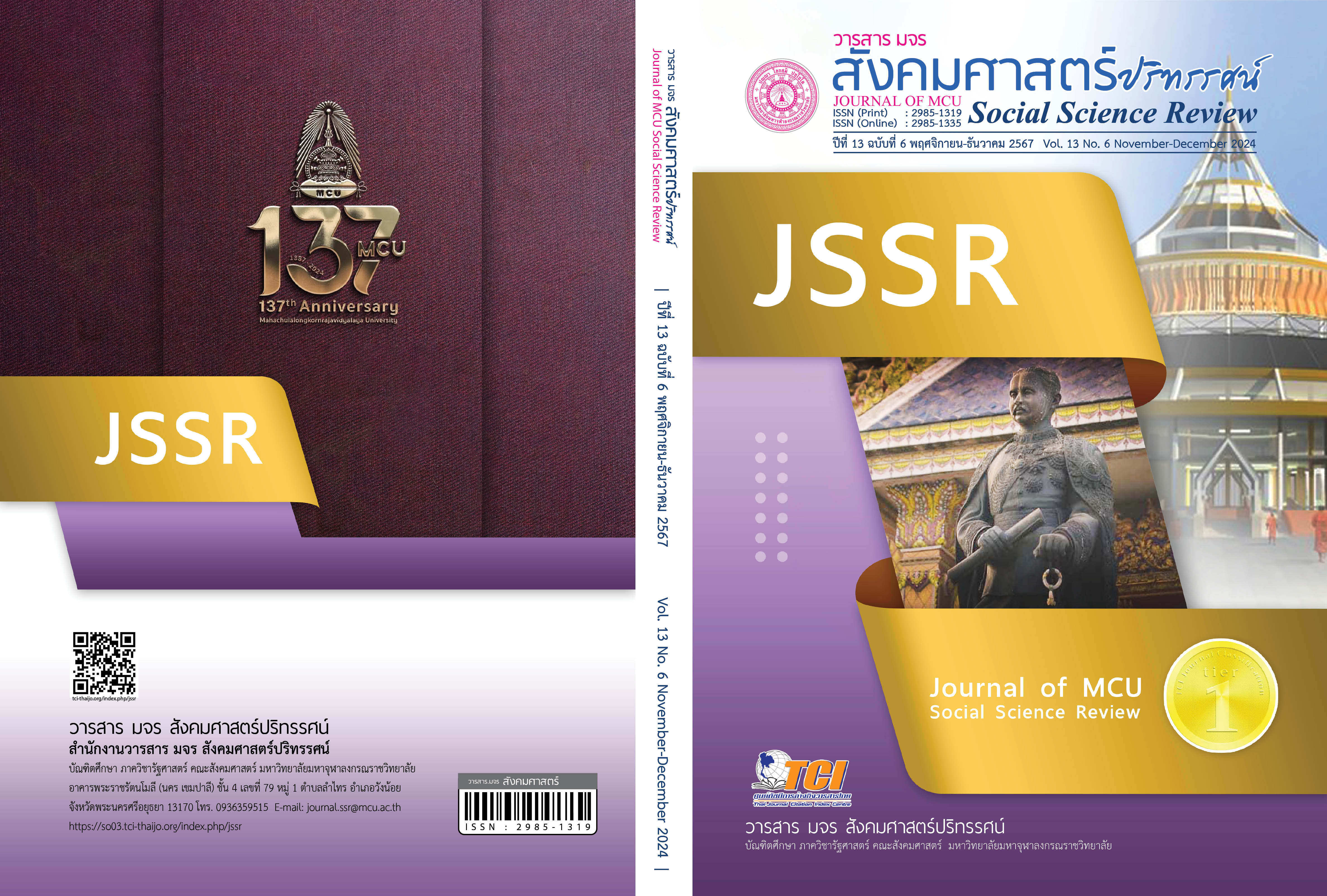ภาวะผู้นำการเปลี่ยนแปลงสู่คุณภาพชีวิตที่ดีในการทำงาน
คำสำคัญ:
หมู่บ้านต้นแบบ, คุณภาพชีวิต, เศรษฐกิจพอเพียงบทคัดย่อ
การเป็นผู้นำการเปลี่ยนแปลงเป็นผู้นำด้านการคิดค้น การเสริมสร้างแรงจูงใจ กระตุ้นให้บุคลากรในองค์กรมีความกระตือรือร้นในการปฏิบัติงาน มีความสามารถในการโน้มน้าวความคิด ทำให้บุคลากรเห็นถึงความสำคัญของสิ่งที่ต้องปฏิบัติ มีคุณลักษณะที่เป็นแบบอย่างที่ดีให้แก่องค์กร รวมถึงสร้างการเปลี่ยนแปลงทั้งความเชื่อ ทัศนคติ การริเริ่ม สิ่งต่าง ๆ ที่เดิม ๆ ให้มีความทันสมัยมากขึ้น ใช้ประสบการณ์ทั้งหมดก่อให้เกิดประโยชน์สูงสุด ส่งผลต่อคุณภาพชีวิตในการทำงานของบุคลากรในองค์กร โดยส่วนใหญ่องค์กรวางกลุยทธ์ไว้ 7 องค์ประกอบ หรือที่รู้จักกันว่า 7S Model’s Mckinsey คือ 1. โครงสร้าง (Structure) 2. กลยุทธ์ (Strategy) 3. ระบบ (Systems) 4. ทักษะ (Skills) 5. รูปแบบ (Styles) 6. บุคลากร (Staffs) 7. คุณค่าที่มีร่วมกัน (Shared Value) ที่ทำให้องค์กรต้องการบุคลากรที่มีความรู้ความสามารถที่สามารถตอบสนองต่อความต้องการขององค์กร เพื่อเป็นส่วนช่วยให้องค์กรสามารถอยู่รอดได้ ซึ่งมีความสำคัญต่อการดำรงชีวิตของบุคลากร นำไปสู่การพัฒนาองค์กร และประสิทธิผลขององค์กร เนื่องจากเป็นกระบวนการที่สามารถทำให้สมาชิกในองค์กรเข้ามามีส่วนร่วมในการทำงาน แสดงให้เห็นถึงความสัมพันธ์ของความพึงพอใจหรือแรงจูงใจในด้านต่าง ๆ เพื่อหาเลี้ยงชีพในการดำรงชีวิตของตนเอง รวมทั้งให้องค์กรเกิดความมั่นคง และความก้าวหน้าให้เท่าทันต่อสภาพแวดล้อมทั้งภายนอกและภายใน โดยอยู่ในรูปแบบของเงินรายเดือน และปัจจัยอื่น ๆ ที่ก่อให้เกิดแรงจูงใจให้บุคลากรทำงานอย่างมีความสุข มีความคิดริเริ่มสร้างสรรค์สิ่งใหม่ ๆ ซึ่งส่งผลให้เกิดความสำเร็จของงาน การเป็นที่ยอมรับ มีความรับผิดชอบ และเกิดพัฒนาในสายงานอาชีพ ให้มีประสิทธิภาพต่อไปในอนาคต
เอกสารอ้างอิง
กมลพร กัลยาณมิตร. (2559). แรงจูงใจ 2 ปัจจัย พลังสู่ความสำเร็จ. วารสารวไลยอลงกรณ์ปริทัศน์ มนุษยศาสตร์และสังคมศาสตร์, 6(3), 175-183.
คมกฤช นันทะโรจพงศ์. (2564). คุณภาพชีวิตในการทำงานและพฤติกรรมการเป็นสมาชิกขององค์การของบุคลากรในอุตสาหกรรมโลหะและวัสดุ: การวิเคราะห์สหสัมพันธ์คาโนนิคอล. วารสารการบัญชีและการจัดการมหาวิทยาลัยมหาสารคาม, 13(2), 109-129.
ชำนาญ คำปัญโญสีโนทัย. (2559). ภาวะผู้นำการเปลี่ยนแปลงผู้บริหารสถานศึกษาโรงเรียนในฝัน (ดุษฎีนิพนธ์ครุศาสตรดุษฎีบัณฑิต สาขาวิชาภาวะผู้นำทางการบริหารการศึกษา). สกลนคร: มหาวิทยาลัยราชภัฏสกลนคร.
ถวิล ศรีใจงาม. (2556). การพัฒนารูปแบบภาวะผู้นำการเปลี่ยนแปลงของผู้บริหารโรงเรียนมัธยมศึกษา สังกัด สำนักงานเขตพื้นที่การศึกษามัธยมศึกษา เขต 1 และเขต 2 (ดุษฎีนิพนธ์ปรัชญาดุษฎีบัณฑิต สาขาวิชาบริหารการศึกษา). กรุงเทพฯ: มหาวิทยาลัยศรีปทุม.
นพดล ไชยสุระ (2560). อิทธิพลของภาวะผู้นำการเปลี่ยนแปลง วัฒนธรรมองค์กรและธรรมาภิบาลต่อประสิทธิผลองค์กรปกครองส่วนท้องถิ่นภาคตะวันออกเฉียงเหนือตอนบน 2 (ดุษฎีนิพนธ์ปรัชญาดุษฎีบัณฑิต สาขาวิชาการบริหารการพัฒนา). สกลนคร: มหาวิทยาลัยราชภัฏสกลนคร.
นพดล ฤทธิโสม. (2558). กลยุทธ์การเสริมสร้างความผูกพันต่อองค์กรของข้าราชการครูสังกัดกรุงเทพมหานคร (ดุษฎีนิพนธ์ปรัชญาดุษฎีบัณฑิต สาขาวิชาการบริหารการศึกษา). กรุงเทพฯ: มหารวิทยาลัยศิลปากร.
ปิยนันท์ สวัสดิ์ศฤงฆาร. (2564). องค์ประกอบ 7 ประการภายในองค์กรซึ่งต้องทำให้สอดคล้องสัมพันธ์กัน. สืบค้น 13 สิงหาคม 2567, จาก https://shorturl.asia/2sFSg
วาริณี โพธิราช. (2558). คุณภาพชีวิตการทํางานของลูกจ้างในมหาวิทยาลัยมหามกุฏราชวิทยาลัย (วิทยานิพนธ์สังคมสงเคราะห์ศาสตรมหาบัณฑิต สาขาวิชาการบริหารและนโยบายสวัสดิการสังคม). ปทุมธานี: มหาวิทยาลัยธรรมศาสตร์.
The Master Class Staff. (2020). What Are the 5 Levels of Maslow’s Hierarchy of Needs?. Retrieved August 15, 2020, from https://shorturl.asia/yfxot
ดาวน์โหลด
เผยแพร่แล้ว
รูปแบบการอ้างอิง
ฉบับ
ประเภทบทความ
สัญญาอนุญาต
ลิขสิทธิ์ (c) 2024 วารสาร มจร สังคมศาสตร์ปริทรรศน์

อนุญาตภายใต้เงื่อนไข Creative Commons Attribution-NonCommercial-NoDerivatives 4.0 International License.
เพื่อให้เป็นไปตามกฎหมายลิขสิทธิ์ ผู้นิพนธ์ทุกท่านต้องลงลายมือชื่อในแบบฟอร์มใบมอบลิขสิทธิ์บทความให้แก่วารสารฯ พร้อมกับบทความต้นฉบับที่ได้แก้ไขครั้งสุดท้าย นอกจากนี้ ผู้นิพนธ์ทุกท่านต้องยืนยันว่าบทความต้นฉบับที่ส่งมาตีพิมพ์นั้น ได้ส่งมาตีพิมพ์เฉพาะในวารสาร มจร สังคมศาสตร์ปริทรรศน์ เพียงแห่งเดียวเท่านั้น หากมีการใช้ภาพหรือตารางหรือเนื้อหาอื่นๆ ของผู้นิพนธ์อื่นที่ปรากฏในสิ่งตีพิมพ์อื่นมาแล้ว ผู้นิพนธ์ต้องขออนุญาตเจ้าของลิขสิทธิ์ก่อน พร้อมทั้งแสดงหนังสือที่ได้รับการยินยอมต่อบรรณาธิการ ก่อนที่บทความจะได้รับการตีพิมพ์ หากไม่เป็นไปตามข้อกำหนดเบื้องต้น ทางวารสารจะถอดบทความของท่านออกโดยไม่มีข้อยกเว้นใดๆ ทั้งสิ้น





